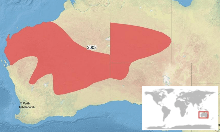Main's frog
| Main's frog | |
|---|---|
| Scientific classification | |
| Kingdom: | Animalia |
| Phylum: | Chordata |
| Class: | Amphibia |
| Order: | Anura |
| Family: | Hylidae |
| Genus: | Cyclorana |
| Species: | C. maini |
| Binomial name | |
| Cyclorana maini Tyler & Martin, 1977 | |
 | |
The Main's frog (Cyclorana maini) is a species of frog in the Hylidae family. It is endemic to Australia.
Habitat
Usually found in temporary pools in watercourses, claypans and other short-lived bodies of water, its habitat also include open grassland, lightly forested areas, tropical dry lowland grassland, intermittent rivers, swamps, intermittent freshwater marshes and stream beds in temporary flood plains.
This water-holding frog has adapted to desert conditions. This species lives in some of the harshest country in the arid region of western and central Australia. Grouped together with other burrowing frogs, it survives the dry periods by absorbing water into its body, burrowing deep underground, and encasing itself in a watertight bag (cocoon), awaiting the next major rain fall.[2]
The frog is named after Professor Bert Main of the University of Western Australia, a pioneer of southern Western Australia frogs.[3]
Description
Its skin may vary from pale grey-brown, olive-brown, dull green on its back, with darker patches. The back is smooth or slightly rough or warty in appearance. Look for the distinct pale stripe that runs along the spine. There is often a dark lateral head stripe.
The male frogs breeding call sounds like the bleating of sheep.
The tadpoles of the Main's frog are fairly large, varying in colour from orange-gold, copper pink over a grey base, dense grey-gold or dull gold with dark speckling.[4]
Some environmental situations, such as the tadpoles living in a small amounts of water, which would naturally heat to higher temperatures, is known to trigger the tadpoles to develop at a faster rate, developing into adults frogs within 14 days.
This seemingly hurried lifecycle from egg to tadpole to adult frogs is a common feature of frogs from the arid and desert region, as water when it does fall is usually only around for a brief period. Nowhere is it more evident then seeing a former pool of water, drying out, still filled with tadpoles that did not grow quick enough to complete their lifecycle.[5]
References
- ↑ Jean-Marc Hero, Paul Horner, Dale Roberts (2004) Litoria maini. In: IUCN 2012. IUCN Red List of Threatened Species. Version 2012.2.
- ↑ Main’s Frog – Cyclorana maini. ausemade.com.au
- ↑ Sheep or Main’s Frog. Western Australian Museum.
- ↑ Australian Frog Database – Cyclorana maini. frogsaustralia.net.au
- ↑ Main’s Frog Tadpoles – Cyclorana maini. ausemade.com.au
External links
- Travel Australia with AusEmade 2001–2008 Frogs. Main's Frog. Main's Frog Images.
